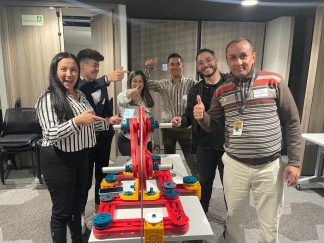The Marshmallow Challenge doesn’t deliver. There are better alternatives.
I love TED talks. I love experiential learning activities. Both have so much potential to reveal powerful and challenging learning. So, you’d think that I’d love a TED talk about experiential learning… but I was disappointed when I saw this Marshmallow Challenge presentation.
It doesn’t deliver what it promises. Here’s why…
What is the Marshmallow Challenge?
In this iteration (and there are many variants out there – like ours, which we’ve tweaked so that it’s actually effective!), several teams of four compete against each other to build the tallest tower they can, using a set amount of uncooked spaghetti sticks, sticky tape and string, within 18 minutes. The finished structure must support a marshmallow on top and be fully freestanding. The team with the tallest legal structure wins.
As you may imagine, this is a memorable and engaging activity. It’s fun, and creates a real buzz. It’s understandable that lots of Learning & Development professionals like to use it; they get good feedback from participants who enjoy the game. But do they get good results?
The activity itself is task-focused. It’s easy to measure success. No matter how complex the team interactions become, or even the spaghetti structures themselves, the best performing team is the one with the tallest tower.
The instructions on how to run this activity are essentially:
- Hand out the materials
- Read the rules out 3 times
- Say ‘go’ and then, 18 mins later, say ‘stop’.
- Measure the highest tower and declare the winners
- Show the presentation slides from the TED talk study of this activity
What it promises versus what it delivers
Several claims are made about the benefits of this team activity and findings of the study, both in the talk and online. They are:
‘Deep lessons about the nature of collaboration’ – but there were none
Effective collaboration is a huge topic with plenty of opportunity for very deep learning. But the only lesson alluded to is that Business School Graduates seem to spend too much time trying to jostle for power. It’s not clear what actionable insight this gives to participants. The focus is on completion of the task, not analysis of the team dynamic, or each individual’s impact upon performance. This is a missed opportunity for rich learning.
‘Helps people identify hidden assumptions’ – for some of the people, some of the time
At the end of this activity the spaghetti tower typically looks great, until the marshmallow is placed on top, when the structure collapses. Because of a false assumption that the marshmallow is light, the team fails to complete the task. So ‘the marshmallow’ is thereafter used as a metaphor which can be used to bring home this point: false assumptions trip us up.
But there are two problems with the supposed Marshmallow metaphor.
Firstly, if the activity is designed to generate the same outcome every time, then it’s not taking you on a journey of self-discovery. It’s just an activity that has set you up to fail so that it can drive home a predetermined lesson for you. Experiential learning has the capacity to be much more open than this, to lead you to unexpected conclusions tailored to you.
Secondly, there is a technical bias to the activity, openly acknowledged in the presentation: engineers and architects consistently build higher towers than all the other groups – towers that don’t fall down when the marshmallow is added. In this activity, this group don’t fall into the ‘hidden assumption’ trap, but it’s because they know about load bearing structures, not because they never make false assumptions. In other words, this metaphor doesn’t work for them either.
‘Proves prototyping is key to success’ – in a lesson without context
There is a conclusion drawn in the presentation, that the high performance of children aged around 5 or 6 is due mostly to their propensity to play. It leads them to prototype right from the start. In the context of this game, this is a neat point. It ignores, however, their lack of propensity to plan, or the dangers that this would pose in a real organisational environment where the resources aren’t pre-determined and finite. The activity is so far removed from most tasks that we need our workforce to complete, that any lessons learned are two dimensional. It’s a shame there isn’t any scope to bring the learnings back into context, or to look at improving future performance. Another opportunity missed.
‘Demonstrates that diverse skills matter’ – but doesn’t focus on the diversity in the room
The presentation cites the improved performance of senior executives when administrators were added to their team. They work, it is supposed, as facilitators to the action-orientated executives. This highlights for me the power of effective facilitation skills quite neatly.
But looking at the results of another team’s efforts is missing a trick. Why not focus on the diversity in your own team while doing this activity, looking at the different personas and traits exhibited? Exploring and valuing the diversity in your team would surely make this a richer and more rewarding exercise.
It’s not all bad news: tips to improve
But enough of the critique! The marshmallow challenge isn’t beyond reform, it just has its limitations, especially when not facilitated well. If all you want is an icebreaker, or a basic exercise to promote creativity or innovation, or to underline some basic engineering fundamentals, then this could serve that purpose.
If, however, you want it to represent true experiential learning, you could gain broader insights from it by changing the format and focus
- Don’t show the presentation. Yes, it’s fun and has some unexpected learnings, but they aren’t particularly actionable (People cheat. People cave under the pressure of financial reward and time limits. Engineers are good at engineering. So what?) Most of all, the problem with the presentation is that it spoon-feeds us with predetermined learnings in a ‘one size fits all’ kind of way. But one size does not fit all. You can do so much more with your personnel than teach them merely to build better spaghetti towers.
- Do keep the learning personal. By focusing people’s attention on their team performance and their own contribution to it, they can learn a lot more of those ‘deep lessons about the nature of collaboration’ that this activity promised. Even those who excel at this experiential activity can reflect on improvements to their behaviour, learned first-hand, that would enable improved performance in the future. Think of the difference to an organisation this kind of approach could make.
The next level…
Due to its simple rules and limited components, the marshmallow challenge can only unlock a relatively small amount of the opportunity available within the sphere of experiential learning activities. If you want to bring about change, you need a mixture of activities with more complex or ambiguous briefs and unclear outcomes. For example, the activities in MTa Insights kit. That’s how to ensure that truly compelling lessons are available to each and every individual regardless of seniority or expertise. It’s also important that facilitators then skilfully guide a process of reflection, putting the learning into context.
And to put a cherry on top, you should lastly aim to provide a safe environment and a new activity to test these behaviours safely, before your participants implement them into their everyday work.
When you look at it this way, I hope you’ll agree with me that the best use for a marshmallow is to toast it gently over an open fire.


